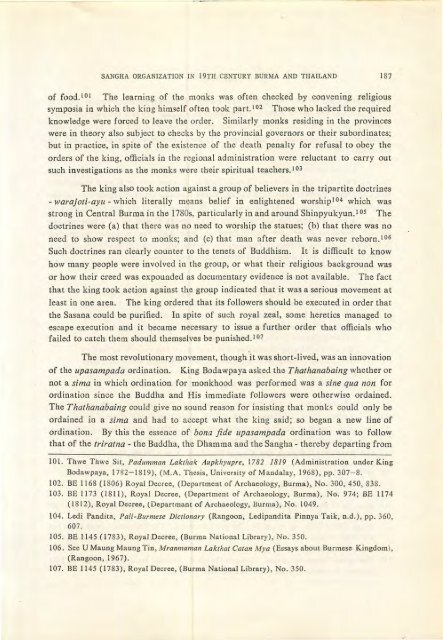The Journal of the Siam Society Vol. LXXII, Part 1-2, 1984 - Khamkoo
The Journal of the Siam Society Vol. LXXII, Part 1-2, 1984 - Khamkoo
The Journal of the Siam Society Vol. LXXII, Part 1-2, 1984 - Khamkoo
You also want an ePaper? Increase the reach of your titles
YUMPU automatically turns print PDFs into web optimized ePapers that Google loves.
SANGHA ORGANIZATION IN 19TH CENTURY BURMA AND THAILAND 187<br />
<strong>of</strong> food.l o 1 <strong>The</strong> learning <strong>of</strong> <strong>the</strong> monks was <strong>of</strong>ten checked by convening religious<br />
symposia in which <strong>the</strong> king himself <strong>of</strong>ten took part. I 02 Those who lacked <strong>the</strong> required<br />
knowledge were forced to leave <strong>the</strong> order. Similarly monks residing in <strong>the</strong> provinces<br />
were in <strong>the</strong>ory also subject to checks by <strong>the</strong> provincial governors or <strong>the</strong>ir subordinates;<br />
but in practice, in spite <strong>of</strong> <strong>the</strong> existence <strong>of</strong> <strong>the</strong> death penalty for refusal to obey <strong>the</strong><br />
orders <strong>of</strong> <strong>the</strong> king, <strong>of</strong>ficials in <strong>the</strong> regional administration were reluctant to carry out<br />
such investigations as <strong>the</strong> monks were <strong>the</strong>ir spiritual teachers. I 03<br />
<strong>The</strong> king also took action against a group <strong>of</strong> believers in <strong>the</strong> tripartite doctrines<br />
- warajoti-ayu- which literally means belief in enlightened worship 104 which was<br />
strong in Central Burma in <strong>the</strong> 1780s, particularly in and around Shinpyukyun.l os <strong>The</strong><br />
doctrines were (a) that <strong>the</strong>re was no need to worship <strong>the</strong> statues; (b) that <strong>the</strong>re was no<br />
need to show respect to monks; and (c) that man after death was never reborn. 1 0 6<br />
Such doctrines ran clearly counter to <strong>the</strong> tenets <strong>of</strong> Buddhism. It is difficult to know<br />
how many people were involved in <strong>the</strong> group, or what <strong>the</strong>ir religious background was<br />
or how <strong>the</strong>ir creed was expounded as documentary evidence is not available.<br />
<strong>The</strong> fact<br />
that <strong>the</strong> king took action against <strong>the</strong> group indicated that it was a serious movement at<br />
least in one area. <strong>The</strong> king ordered that its followers should be executed in order that<br />
<strong>the</strong> Sasana could be purified. In spite <strong>of</strong> such royal zeal, some heretics managed to<br />
escape execution and it became necessary to issue a fur<strong>the</strong>r order that <strong>of</strong>ficials who<br />
failed to catch <strong>the</strong>m should <strong>the</strong>mselves be punished.! 07<br />
<strong>The</strong> most revolutionary movement, though .it was short-lived, was an innovation<br />
<strong>of</strong> <strong>the</strong> upasampada ordination. King Bodawpaya asked <strong>the</strong> Thathanabaing whe<strong>the</strong>r or<br />
not a sima in which ordination for monkhood was performed was a sine qua non for<br />
ordination since <strong>the</strong> Buddha and His immediate followers were o<strong>the</strong>rwise ordained.<br />
<strong>The</strong> Thathanabaing could give no sound reason for insisting that monks could only be<br />
ordained in a sima and had to accept what <strong>the</strong> king said; so began a new line <strong>of</strong><br />
ordination. By this <strong>the</strong> essence <strong>of</strong> bona fide upasampada ordination was to follow<br />
that <strong>of</strong> <strong>the</strong> triratna- <strong>the</strong> Buddha, <strong>the</strong> Dhamma and <strong>the</strong> Sangha- <strong>the</strong>reby departing from<br />
101. Thwe Thwe Sit, Padumman Lakthak Aupkhyupre, 1782 1819 (Administration under King<br />
Bodawpaya, 17 82-1819), (M.A. <strong>The</strong>sis, University <strong>of</strong> Mandalay, 1968), pp. 307- 8.<br />
102. BE 1168 ( 1806) Royal Decree, (Department <strong>of</strong> Archaeology, Burma), No. 300, 450, 838.<br />
103. BE 1173 ( 1811), Royal Decree, (Department <strong>of</strong> Archaeology, Burma), No. 974; BE 1174<br />
( 1812), Royal Decree, (Departmant <strong>of</strong> Archaeology, Burma), No. l 049. ·<br />
104. Ledi Pandita, Pali-Burmese Dictionary (Rangoon, Ledipandita Pinnya Taik, n.d.), pp. 360,<br />
607.<br />
105. BE 1145 (1783), Royal Decree, (Burma National Library), No. 350.<br />
106 . See U Maung Maung Tin, Mranmaman Lakthat Catan Mya (Essays about Burmese Kingdom),<br />
(Rangoon, 1967).<br />
107. BE 1145 (1783), Royal Decree, (Burma National Library), No. 350.

















